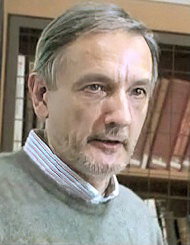Biography:Laurent Nottale
The neutrality of this article is disputed. (June 2016) (Learn how and when to remove this template message) |
Laurent Nottale | |
|---|---|
 | |
| Born | 29 July 1952 |
| Known for | Gravitational Lens, Scale relativity |
| Scientific career | |
| Fields | Physics |
| Institutions | CNRS, Paris observatory |
Laurent Nottale (born 29 July 1952) is an astrophysicist, a retired director of research at CNRS, and a researcher at the Paris Observatory. He is the author and inventor of the theory of scale relativity, which aims to unify quantum physics and relativity theory.
Scientific career
Nottale began his professional work in the domain of general relativity. He defended his PhD Thesis in June 1980, entitled "Perturbation of the Hubble relation by clusters of galaxies", in which he showed that clusters of galaxies as a whole may act as gravitational lenses on distant sources.[1] Some of these results were reported in Nature.[2][3]
He also published a popular book L'Univers et la Lumière, Flammarion, Nouvelle Bibliothèque Scientifique 1994, Champs 1998) for which he received a prize in 1995 (Prix du livre d'Astronomie Haute-Maurienne-Vanoise).
According to Vincent Bontems and Yves Gingras there are two distinct phases in Nottale's scientific career.[4] From 1975 to 1991 this included conventional topics, such as gravitational lenses, while from 1984 onwards he focused on developing his theory of scale relativity, a proposal for a theory of physics based on fractal space-time.
The theory of scale relativity
The theory of scale relativity emerged out of a desire to establish a foundation for quantum mechanics based on first physical principles: the principle of relativity, the geometric interpretation of physical properties and the optimization principle interpreted as a geodesic principle.[5] In a similar way that gravity is the manifestation of the intrinsic curved geometry of spacetime in general relativity, the quantum properties here are the manifestation of another property of spacetime at small scales, its intrinsic non-differentiability.[6] Besides proposing a better foundation for microphysical quantum mechanics, it also proposes that many macroscopic classical systems with highly chaotic behaviour can be considered as non-differentiable and thus described by macroscopic quantum-like laws.[7] Examples of such applications are: planetary formation in the protoplanetary disk phase,[8][9][10] violent ejection processes such as the creation of planetary nebulae[11] or turbulence in fluids.[12][13] The proposal has not attracted wide acceptance by the scientific community.[14]
Selected publications
- Scale Relativity And Fractal Space-Time: A New Approach to Unifying Relativity and Quantum Mechanics. 2011 1st ed. World Scientific Publishing Company. (ISBN:1848166508)
- Fractal Space-Time and Micro-physics, Editions World Scientific, May 1993 (ISBN:9810208782) (The reference book about Scale Relativity theory).
- L'univers et la lumière, Cosmologie classique et mirages gravitationnels, Éditions Flammarion, août 1993 (ISBN:2082111830)
- La Relativité dans tous ses états : du mouvements aux changements d'échelle, Éditions Hachette, 1998 (ISBN:201279002X)
- Les arbres de l'évolution, Laurent Nottale, Jean Chaline et Pierre Grou, Éditions Hachette, mars 2000 (ISBN:2012355528)
See also
References
- ↑ in French: "Les lentilles gravitationnelles par amas de galaxies"
- ↑ Karoji, H.; Nottale, L. (1976). "Possible implications of the Rubin-Ford effect". Nature 259 (5538): 31–33. doi:10.1038/259031a0. Bibcode: 1976Natur.259...31K.
- ↑ Nottale, L.; Vigier, J. P. (1977). "Continuous increase of Hubble modulus behind clusters of galaxies". Nature 268 (5621): 608–610. doi:10.1038/268608a0. Bibcode: 1977Natur.268..608N.
- ↑ Bontems, Vincent; Gingras, Yves (2007). "De la science normale à la science marginale. Analyse d'une bifurcation de trajectoire scientifique: le cas de la Théorie de la Relativité d'Echelle". Information Sur les Sciences Sociales 46 (4): 607–653. doi:10.1177/0539018407082595. http://www.archipel.uqam.ca/481/1/gingras_bontems_SSI.pdf.
- ↑ Nottale, L. (1993). Fractal Space-Time and Microphysics. World Scientific Publishing. doi:10.1142/1579. ISBN 978-981-02-0878-3.
- ↑ Nottale, L. (1989). "Fractals and the Quantum Theory of Spacetime". International Journal of Modern Physics A 04 (19): 5047–5117. doi:10.1142/S0217751X89002156. Bibcode: 1989IJMPA...4.5047N.
- ↑ Nottale, L. (2011). Scale Relativity and Fractal Space-time: A New Approach to Unifying Relativity and Quantum Mechanics. World Scientific Publishing. doi:10.1142/p752. ISBN 978-1-84816-650-9. Bibcode: 2011srfs.book.....N.
- ↑ Nottale, L. (1996). "Scale relativity and quantization of extra-solar planetary systems". Astronomy and Astrophysics 315. Bibcode: 1996A&A...315L...9N.
- ↑ Nottale, L. (1997). "Scale relativity and quantization of the solar system". Astronomy and Astrophysics 322: 1018. Bibcode: 1997A&A...322.1018N.
- ↑ Nottale, L. (2000). "Scale relativity and quantization of exoplanet orbital semi-major axes". Astronomy and Astrophysics 361: 379. Bibcode: 2000A&A...361..379N.
- ↑ da Rocha, D.; Nottale, L. (2003). "On the morphogenesis of stellar flows: application to planetary nebulae". arXiv:astro-ph/0310031.
- ↑ Nottale, L.; Lehner, T. (2019). "Turbulence and scale relativity". Phys. Fluids 31 (10). doi:10.1063/1.5108631. Bibcode: 2019PhFl...31j5109N.
- ↑ Nottale, L.; Lehner, T. (2023). The turbulent jet in the scale relativity framework. https://hal.science/hal-04272392v1/document.
- ↑ Peter, Patrick (2013). "Laurent Nottale: Scale relativity and fractal space-time". General Relativity and Gravitation 45 (7): 1459–61. doi:10.1007/s10714-013-1535-8. Bibcode: 2013GReGr..45.1459P. https://hal.archives-ouvertes.fr/hal-03645526/file/Peter2013.pdf.
External links
- Laurent Nottale's personal page
- 265 articles on line (1975-2021) : Google Scholar
 |

